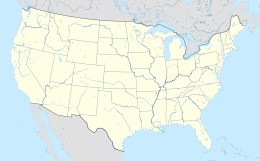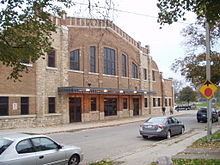훅스 섬
Hooks Island 2020년 9월 팔로알토 베일랜즈 세일링 스테이션에서 본 훅스 아일랜드 | |
| 지리 | |
|---|---|
| 위치 | 캘리포니아 북부 |
| 좌표 | 37°27(22°N) 122°05′51″w/37.45611°N 122.09750°W좌표: 37°27°22°N 122°05°51°W / 37.45611°N 122.09750°W / |
| 인접 수역 | 샌프란시스코 만 |
| 전체 섬 | 1 |
| 지역 | 36에이커[1](15ha) |
| 행정부. | |
미국 | |
| 주 | |
| 자치주 | 산타클라라 |
| 도시 | 팔로알토 |
훅스 섬은 미국 캘리포니아주 팔로알토에 있는 샌프란시스코 만에 있는 약 36에이커(15ha)[1]의 무인도 조석염 습지[2] 섬입니다.2010년대에 이곳은 위험에 가까운 수십 개의 캘리포니아 딱따구리의 보금자리였던 것으로 관측되었다.
지리
샌프란시스코 만 주변의 많은 지역들과 마찬가지로, 훅스 섬은 캘리포니아 해안 소금 습지로 분류됩니다.Palo Alto Baylands 자연보호구역의 일부로서, 그곳은 보호구역이며, 지방정부는 사람들이 [3]그곳에 여행하는 것을 금지하고 있다. 샌프란시스코 베이 구역의 많은 부분과 마찬가지로, 개발(특히 주택의)은 [4][5]허용되지 않는다.
멸종 위기에 처한 여러 종의 구성원들과 5개의 송전탑(Ravenswood-Ames 115kV 송전선에 해당)이 있습니다.2020년 산타클라라 밸리 보고서에 따르면, 이 습지는 "해수간 신생 습지"[1]의 일부로 구성된 "방해되지 않은 조수 염습지"로 묘사되어 있다.37°27°30°N 122°05°49°W / 37.45833°N 122.09694°W / 에 위치한 북쪽 끝은 후크 [6]포인트라고 불립니다.Hooks Island는 Palo Alto Baylands 세일링 스테이션 [3]바로 동쪽에 위치해 있습니다.
식물군
이 섬에는 여러 종의 억새풀이 자라며 다양한 동물들의 서식지를 제공한다.1997년, 한 연구는 토종 제비풀인 스포로볼루스 폴리오수스가 토종 제비풀보다 밀집한 서식지에서 자라는 경향이 있는 침입종인 스파르티나 알터니플로라에 의해 훅스 섬에서 대체되고 있다는 것을 발견했는데, 이는 "동물이 움직이기 어렵게 만든다"[7]는 것이다.
1973년 육군 공병대에 의해 이 지역에 처음 도입된 알터니플로라는 토종 줄풀과 교배하여 땅 위에 빽빽하게 자라고 아래에 빽빽한 뿌리 시스템을 형성하여 만에서 침식을 통제하고 습지를 복원하는 프로젝트를 수행했습니다. 이것은 지표에 사는 동물과 [8]진흙 아래에 사는 동물 모두를 대체했습니다.
1973년 습지에 대한 피해를 되돌리려는 시도가 결국 야생동물에게 해롭다는 것이 밝혀졌을 때, 캘리포니아 해안 관리소의 샌프란시스코 하구침습 스파르티나 프로젝트는 제초제 이미지 치료사의 도움과 물리적 제거 방법을 통해 S 대안의 전체적인 발자국을 크게 줄일 수 있었다.iflora 성장: 7만 에이커(28,000 ha)의 "작업 영역"에서 2005년 805 에이커(326 ha)에서 2016년 28 에이커(11 ha)(3000만 달러가 사용됨)[8]로 확대.샌프란시스코 만 국립 야생동물 보호단지의 관리자에 따르면, 이 프로젝트는 "대단한 성공"[8]이었다.
그러나 프로젝트의 성공에도 불구하고, (당시 위험에 처했던)[8][9] 캘리포니아 딱따구리 레일이 침습종의 덤불에 거주한 것으로 판명된 후, 연방 공무원들은 초기 역전의 일부를 되돌릴 것을 관리 당국에 요구했다.
동물군
멸종 위기에 가까운 캘리포니아 딱따구리와 같은 수많은 새들이 [10]훅스 섬에 살고 있는 것으로 알려져 왔다.2011년, 포인트 레예스 버드 천문대 보존 과학 보고서는 약 14개의 딱따구리 레일이 베일랜즈에서 발견되었고, 19개의 딱따구리 레일이 팔로 알토 하버와 [11]훅스 섬에서 "존재하는 것으로 알려져 있다"는 것을 발견했습니다.2011년 베이랜드 전체 인구 추정치에는 "약 15-29명"[2]이 포함되었다.하지만 2010년에는 22개의 클래퍼 [11]레일이 있었다.2013년, 야생 고양이가 훅스 섬에 살며 클래퍼 [11]레일을 죽이고 있다는 주장이 제기되었습니다.샌프란시스코 베이 [12]에리어에 많은 고양이가 있다는 것은 널리 받아들여지고 있지만, 팔로 알토 베일랜즈(그리고 찰과상 레일 살상에서의 그들의 역할)에 대해서는 논란이 있었다.이 도시의 열린 공간, 공원, 골프 부문 관리자가 "베이랜드 자연보호구역에서 야생 고양이가 새를 사냥하고 잡는 것을 개인적으로 보았다"고 주장한 반면, 팰로 알토 휴메인 소사이어티의 한 자원봉사자는 "사람과 비교했을 때, 야생 고양이들의 피해는 미미하다"[11]며 이 주장에 대해 반박했다.
「 」를 참조해 주세요.
레퍼런스
- ^ a b c "Palo Alto Flood Basin Tide Gate Structure Replacement Project" (PDF). Santa Clara Valley Water. September 2020. p. 42. Archived (PDF) from the original on 2 October 2020. Retrieved 15 September 2020.
- ^ a b Petra Unger; Diana Edwards (December 2017). Palo Alto Baylands: Existing Conditions (Report). AECOM, 2020 L Street, Suite 400, Sacramento, CA 95811. Archived from the original on 16 September 2020. Retrieved 15 September 2020.
- ^ a b "San Francisco Bay Area Water Trail: Site Description for Palo Alto Baylands Sailing Station" (PDF). California State Coastal Conservancy. 29 May 2012. Archived (PDF) from the original on 6 June 2017. Retrieved 15 September 2020.
Boat users need to be sensitive to wildlife, high tide refugia, and marsh habitat, observe buffer distances, and not land in any location besides the Sailing Station, including Hooks Island, located across from the Sailing Station. Additionally, there are areas located nearby where a boater who lands inappropriately could disturb nesting Western burrowing owls (Mountain View) or Western snowy plovers (Alviso or Ravenswood). The City of Palo Alto Municipal Code prohibits trampling vegetation and/or harassing wildlife and non‐permitted activities in the marsh constitute violations and are subject to fines of $1,000 or more
- ^ "Palo Alto Open Space". City of Palo Alto. Archived from the original on 14 May 2018. Retrieved 15 September 2020.
- ^ "History of Baylands Nature Preserve". City of Palo Alto. 1 June 2007. Archived from the original on 2 October 2020. Retrieved 15 September 2020.
- ^ "GNIS Detail – Hooks Point". U.S. Geological Survey Geographic Names Information System. 9 April 1999. Retrieved 15 September 2020.
- ^ Dremann, Sue (1 November 2013). "Saving the Baylands: Scientists, nonprofit groups work to protect Palo Alto marshlands". Palo Alto Online. Archived from the original on 6 February 2017. Retrieved 15 September 2020.
- ^ a b c d Rogers, Paul (17 April 2016). "San Francisco Bay: Massive effort to remove aquatic invader nearly finished". The Mercury News. Bay Area News Group. Archived from the original on 3 May 2017. Retrieved 15 September 2020.
- ^ Poor, William (7 August 2018). "This monster plant is taking over Silicon Valley—should we let it?". The Verge. Archived from the original on 26 September 2020. Retrieved 15 September 2020.
- ^ BirdLife International (2020). "Rallus obsoletus". IUCN Red List of Threatened Species. 2020: e.T22731577A178663850. doi:10.2305/IUCN.UK.2020-3.RLTS.T22731577A178663850.en. Retrieved 11 November 2021.
- ^ a b c d Dremann, Sue (14 September 2013). "Wildlife experts: Cats are killing Baylands wildlife". Palo Alto Weekly. Retrieved 15 September 2020.
- ^ Eslinger, Bonnie (14 November 2013). "East Palo Alto man says city is a dumping ground for feral cats". The Mercury News. San Mateo County Times, Bay Area News Group. Archived from the original on 10 May 2017. Retrieved 15 September 2020.












